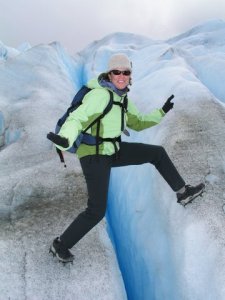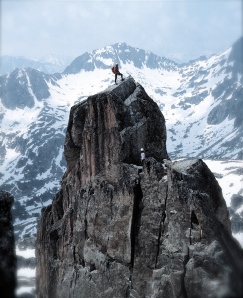We don’t know about you, but we seem to possess the adventurous logic-be-dammed attitude of 25-year-olds, the curiosity of a 6-year-old and here’s the rub, the bodies of midlife computer geeks. It’s one hellofva wild combo.
Enter Marcus Shapiro, adventure traveler, fitness specialist and founder of the new website FitForTrips.com. Shapiro and his team spent five years researching and producing adventure-specific workouts to prepare travelers for anything from rafting the rapids of the Grand Canyon’s Colorado River to summiting Kilimanjaro.
The Wild Pair recently spoke with Marcus about ways any traveler can get physically primed for their next adventure. Whether you’re a beginner preparing for a hiking vacation in the Canadian Rockies, a long distance runner booked to cycle the coast of Sicily or an elite mountaineer headed off for a multi-day kayaking vacation in Mexico’s Sea of Cortez, here are five expert tips to help you get fit for your trip.
1) Change from a general fitness program to a trip specific workout
Within 8 to 15 weeks of your departure date, replace your general fitness program with a trip-specific program. A general fitness plan is the perfect strategy for everyday fitness, but a trip specific program prepares you for the movements and stresses you will encounter on your trip. It will also help you avoid the most common injuries associated with the activities in your itinerary. For instance, if you are attempting to summit mountains, you will be trekking on steep grades, which really beats up your Achilles tendon and calf muscle complex. A masochistic workout on the stepper (i.e. StairMasterÒ) will strengthen your thighs and gluteal muscles, but it will not sufficiently strengthen and lengthen the muscles in your lower leg. Walking on an inclined treadmill, or better yet, hiking steep grades will decrease your chances of straining your lower leg on the trail. Also, add some pack weight to your treadmill workout. This, and other trip specific exercises, will prepare you for long days of trekking.
2) Train for movement not muscle mass
 Sticking with the mountain climbing example, you will need to train the muscles, nerves, and ligaments in your legs to work together synergistically to successfully hike the steep grade. Reverse lunges, for example, force you to use your quadriceps, hamstrings, calf muscles, gluteal muscles, and core muscles simultaneously. If you are preparing for alpine scrambling, performing a machine chest fly, a tricep pushdown and a side shoulder raise will strengthen the necessary muscles, but push-ups will do better. The various parts of your body are learning to work together to accomplish the specific task you are setting out to do.
Sticking with the mountain climbing example, you will need to train the muscles, nerves, and ligaments in your legs to work together synergistically to successfully hike the steep grade. Reverse lunges, for example, force you to use your quadriceps, hamstrings, calf muscles, gluteal muscles, and core muscles simultaneously. If you are preparing for alpine scrambling, performing a machine chest fly, a tricep pushdown and a side shoulder raise will strengthen the necessary muscles, but push-ups will do better. The various parts of your body are learning to work together to accomplish the specific task you are setting out to do.
3) Train in phases – increase the intensity and complexity of your workout as your trip approaches
To prepare for a trip, you want to systematically change the exercises, level of intensity, repetitions and other elements of training over a period of 8 to 15+ weeks to ensure gradual improvements in your level of fitness leading to a peak level of optimal physical performance at the exact time you depart for your adventure vacation. Split your training into three phases – each phase made up of four-week blocks – adding intensity and complexity over time. In the first phase, establish a base level of fitness working mostly on strength: perform basic squats, deadlifts and lunges. In the second, add a little more complexity that involves the core muscles and balance: eliminate the two leg exercises (i.e. squat, deadlift) and include single leg squats and single leg step-ups to a high bench. In the third phase combine strength, balance and add power and agility: perform single leg jumps, walking lunges with a powerful skip, single leg step-ups onto a bench jumping as high as you can.
4) Taper your workout the week before you leave for your trip
Tapering means a reduction in workload and intensity at the end of a training regimen. If you’re an athlete, you probably already taper your workouts prior to a major competition. Tapering properly the week prior to your departure will allow your body to completely recover and heal from the demands you have placed on it over the course of your training program. This does not mean stopping completely, but a reduction in volume, intensity and duration. Your goal is to maintain mobility and joint movements but let your neuromuscular system fully recuperate. A safe way to accomplish this is to return to basic exercises and reduce your resistance training workouts to one set per exercise, around a 12-15 repetition range where you feel no “burn” at all. Additionally, reduce your endurance training to half the duration and 2/3 the intensity. It’s a good sign if you want more and it feels like you are not accomplishing much in your work out. Just remember, it is better to under train the last week than overstrain.
5) Modify your diet slightly while you train for your trip
Your goal is to reduce body fat while not losing muscle so that it’s easier to paddle, trek, climb or cycle your way from point A to B. One’s diet is personal and each body operates at its prime on a unique set of dietary choices, but generally the best way to reduce body fat without losing muscle is to replace some of your carbohydrate calories with additional proteins. The most important thing to do before your trip is to feed your body the nutrition it needs.
Photo Credits: flickr by Xevi V ;by Kathy Dragon of TravelDragon.com
